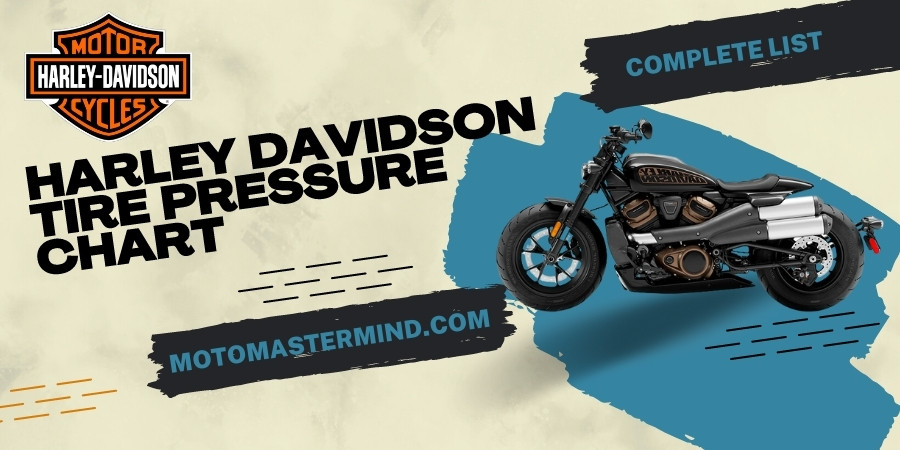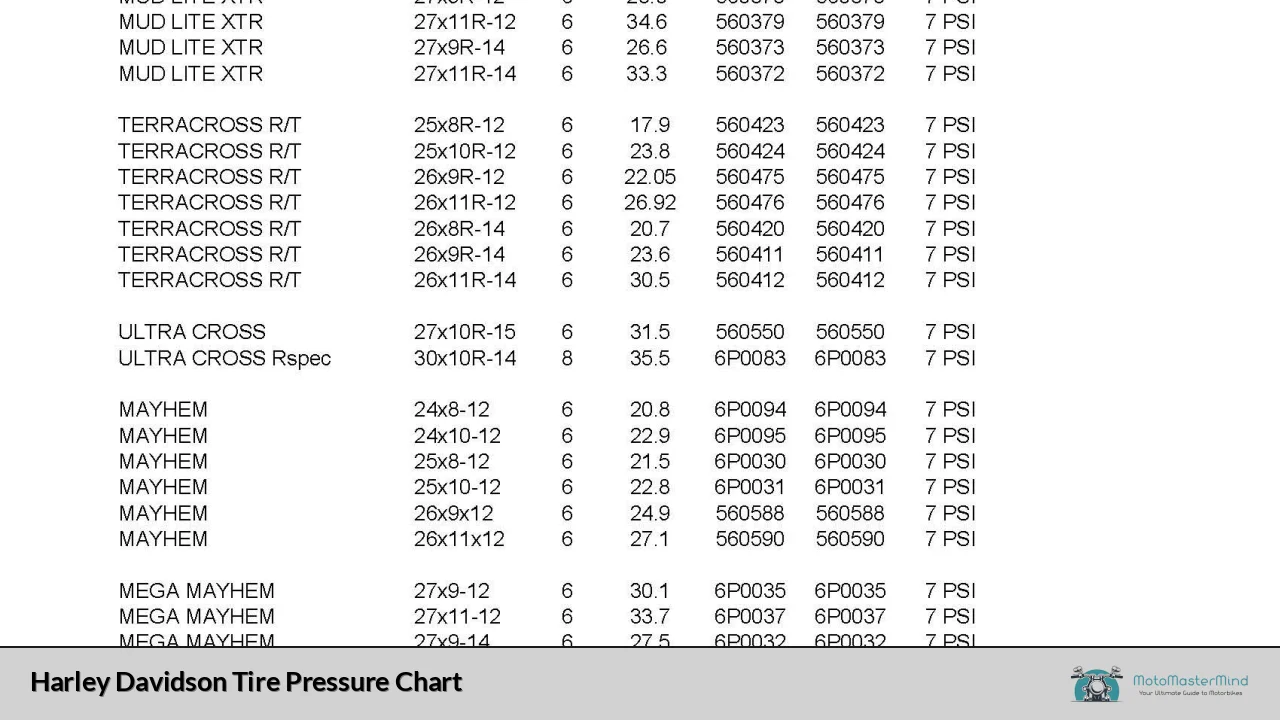
Ensuring a Harley Davidson motorcycle operates at peak performance involves many factors, including maintaining the correct tire pressure. Adhering to the manufacturer’s recommended tire specifications is crucial, as it boosts fuel efficiency and significantly extends the tire’s lifespan. The Harley Davidson Tire Pressure Chart provides invaluable information, making it a breeze to ascertain the correct tire pressure for a specific Harley Davidson bike model, optimizing its performance.
Harley Davidson recommends 36PSI and 40PSI pressure for front and rear tires, although these figures can vary depending on your bike type. The size of each tire should also be considered, as different models require different sizes; therefore, an examination by a professional may be necessary to determine what size will best suit your individual needs. Additionally, while all types of tires are suitable for use with Harley Davidsons, some specifically designed models are preferred by them due to their superior level of quality control.
Harley Davidson Tire Pressure Chart
Harley Davidson motorcycles are renowned for their performance and style, so it is essential to ensure proper tire pressure to maintain optimal performance. The recommended tire pressure for each of the famous Harley models varies depending on the type of bike but typically ranges between 36PSI and 40PSI in cold temperatures. It is important to note that this will vary depending on the region or climate you are riding in; adjust accordingly if necessary. Proper maintenance includes monitoring your tires’ air pressure levels regularly and checking your tires for signs of wear and tear, such as cracks or bulging. With regular care and attention to detail, you can be sure your Harley will always perform at its best.
Complete Harley Davidson Tire Pressures According to Other Versions:

Harley Davidson has provided generations of motorbike fans with classic and stylish vehicles. Each generation has been given its distinctive name, representing its style and era. This article will present readers with recommended tire pressure guidelines for all Harley Davidson models.
| Harley Davidson Models | Front Tire Recommended Pressure | Rear Tire Recommended Pressure |
|---|---|---|
| Dyna | 36PSI | 42PSI |
| Electra Glide | 36PSI | 40PSI |
| FXDC Super Glide | 30PSI | 36PSI |
| Harley-Davidson 1200 Custom | 30PSI | 36PSI |
| Harley-Davidson Fat Boy | 36PSI | 42PSI |
| Harley Forty-Eight | 36PSI | 40PSI |
| Harley Forty-Eight Special | 36PSI | 40PSI |
| Harley Iron 883 | 30PSI | 40PSI |
| Harley Low Rider | 32PSI | 36PSI |
| Heritage Softail Classic | 36PSI | 40PSI |
| Pan America 1250 | 32PSI | 36PSI |
| Road King | 36PSI | 40PSI |
| Street Rod | 32PSI | 36PSI |
| Super Low Rider | 36PSI | 42PSI |
Harley Davidson recommends maintaining tire pressure between 36PSI and 40PSI in most motorcycle models for optimal performance. However, the exact pressure can vary slightly from model to model, so it is essential to refer to the user manual or chart provided by Harley Davidson before adjusting tire pressure. Doing this will ensure that your motorcycle tires are running at their best, and you can enjoy a better riding experience.
It is crucial to maintain the appropriate tire pressure
The “Rule of 2” is a method to determine the correct tire pressure for motorcycles in different conditions. It involves adding or subtracting two pounds per square inch (PSI) based on the terrain type, road surface, and whether one is riding in. Many motorcyclists find this approach helpful because it allows them to adjust their tires accordingly to ensure optimal performance and safety on the road.
Highway streets:
When riding on highway streets, adding 2PSI of pressure to the tire is recommended compared to cold conditions. For instance, a Harley Davidson Softail typically has a tire pressure of 36PSI and 40PSI in cold conditions. However, by adding an extra 2PSI while driving the Softail model on highways, the preferable tire pressure becomes 38PSI and 42PSI, respectively.
Driving in summer:
When driving a Harley motorcycle in the summertime, it is essential to remember that tire pressure needs to be adjusted. Specifically, for Street Glide models, subtracting 2PSI from the initial 36PSI and 40PSI pressure of the front and rear tires will provide optimal tire engagement. Doing this helps ensure sufficient pressure when conditions are warmer than usual.
Driving in the mountains:
At high altitudes and mountainous areas, it is essential to be mindful of tire pressure when driving. The recommended summer tire pressure should be two PSI lower than the original manufacturer’s recommendations to ensure optimal performance. Paying close attention to these details is essential for safe and successful travel on any terrain.
Tips for Checking Tire Pressure

Upon perusing the tire pressure chart specifically designed for Harley Davidson motorcycles, the question arises: how can the correct tire pressure be discerned? A straightforward, five-step process will guide one through this assessment quickly.
- Locate the tire’s air cap valve and proceed with its safe removal.
- Once the valve is open, swiftly press the tire pressure-measuring gauge onto it, allowing the air to function without interference.
- The ensuing task involves checking the reading on the tire pressure gauge monitor. Using traditional or digital tire pressure gauges is at one’s discretion.
- The subsequent action involves the comparison of these readings with the recommended pressures on the Harley chart.
- If a discrepancy is observed, adjustments to the pressure of the front or rear tires should be made accordingly.
These straightforward steps should require no more than a few minutes of one’s time. It is, therefore, advisable to carry out this tire pressure measurement and adjustment at a minimum frequency of twice a month.
Final Thoughts on Harley Davidson Tire Pressure Chart
The Harley Davidson Tire Pressure Chart is an indispensable tool, offering clear guidelines on maintaining the correct air pressure for motorcycle tires. The importance of timing in checking and adjusting tire pressure cannot be overstated. It should be performed in sync with changes in road conditions and personal driving habits. By adhering to the recommendations in this chart, one can ensure a ride that is as safe as it is enjoyable.

